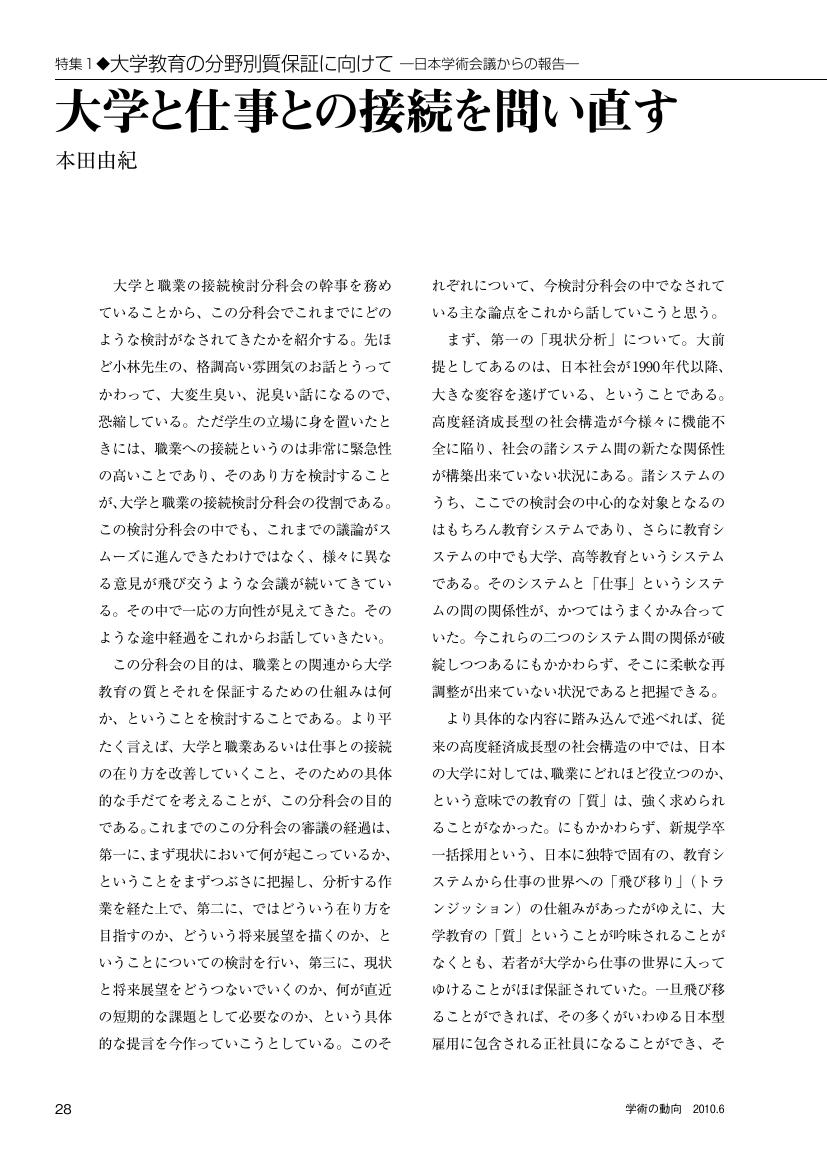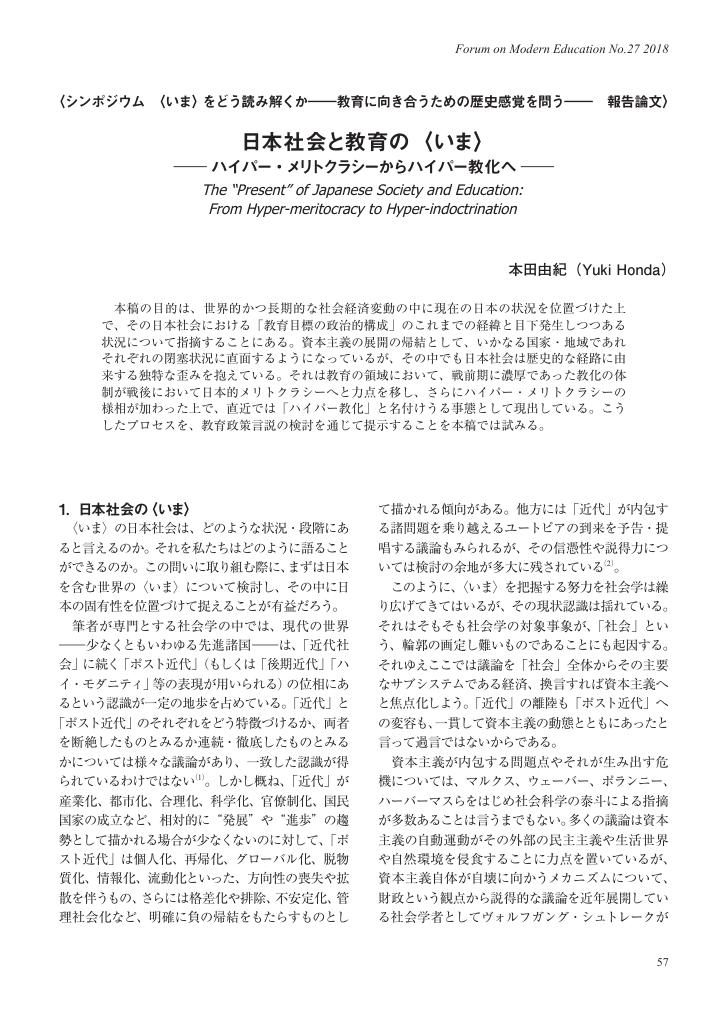- 著者
- 本田 由紀
- 出版者
- 一般社団法人 日本教育学会
- 雑誌
- 教育学研究 (ISSN:03873161)
- 巻号頁・発行日
- vol.78, no.2, pp.114-125, 2011
本稿は、日本の教育がボーダーレス化しているか否かをめぐって学校教育と労働および福祉との関係を概観し、学校教育はいまだに硬直的に閉鎖化している面が大きいという認識を示す。そうした状況を解釈するための理論としてルーマンの社会システム論を参照し、日本の学校教育が<有能/無能>という選抜の二項コードに支配されている状態を脱するには、学習者に「別の可能性」を提示する機能とパラドクス展開の強化が必要であることを主張する。
- 著者
- 本田 由紀
- 出版者
- 岩波書店
- 雑誌
- 世界 (ISSN:05824532)
- 巻号頁・発行日
- no.762, pp.109-119, 2007-03
- 著者
- 本田 由紀 堤 孝晃
- 出版者
- 政治経済学・経済史学会
- 雑誌
- 歴史と経済 (ISSN:13479660)
- 巻号頁・発行日
- vol.56, no.3, pp.23-33, 2014-04-30 (Released:2017-08-30)
Since the 1970s, Japan's high-school system has been characterized by a lack of institutional diversity, or in other words by an oversupply of general studies programs and undersupply of vocational programs. This paper reexamines the social context of the 1970s policy shift and proposes an alternative to the dominant view that the striking decline of high-school vocational courses in the 1970s and '80s was the inevitable result of their dysfunctions. In the 1960s, Japan's educational policy-makers pursued the institutional diversification of high schools in response both to the high demand for trained manpower in developing industries and to the increase in the proportion of students advancing to high school. Around 1970, however, educational policy made an about-face, depreciating vocational programs and promoting the flexible and individualized approach of general coursework. One possible explanation for this abrupt change in policy is that just when the Japanese government was facing serious financial challenges following the oil shock in 1973, it was also confronted with the need to establish more and more high schools, especially in metropolitan areas which had seen significant population increases during the high-growth years of the '60s. The only way to reconcile these conflicting circumstances was to establish general studies programs, the construction and operation of which were far cheaper than those of vocational courses. Another possible factor was the demand for general-studies high schools by members of the upper and middle classes, including government officials, teachers and academics, who most highly valued the path to university and white-collar careers. These factors together served to counteract and overwhelm the demand for vocational education that persisted from small and medium-size enterprises and from families that expected their children to take stable jobs after graduating high school. The result was the establishment of vertical diversification among schools and among students within general courses and the steady decline of the relevance of high-school education to occupational training. This study suggests the need for a thorough reconsideration of Japan's high-school policies, both past and present.
6 0 0 0 OA 人文社会科学系大学教育の内容・方法とその職業的レリバンスに関するパネル調査研究
- 著者
- 本田 由紀 濱中 義隆 中村 高康 小山 治 上西 充子 二宮 祐 香川 めい 小澤 昌之 堤 孝晃 河野 志穂 豊永 耕平 河原 秀行 西舘 洋介
- 出版者
- 東京大学
- 雑誌
- 基盤研究(B)
- 巻号頁・発行日
- 2012-04-01
本研究は、人文社会科学系大学教育の分野別の職業的レリバンスを把握することを目的とし、①大学3年時点から卒業後2年目までのパネル調査、②25~34歳の社会人を対象とする質問紙調査、③大学生・卒業生・大学教員を対象とするインタビュー調査を実施した。その結果、主に以下の知見が得られた。(1)人文社会科学系の大学教育の内容・方法には分野別に違いが大きく、教育の双方向性・職業との関連性の双方について教育学・社会学は相対的に水準が高いが、経済学・法学等の社会科学は前者の、哲学・歴史学等の人文科学は後者の、それぞれ水準が相対的に低い。(2)大学教育の内容・方法は卒業後の職業スキルに影響を及ぼしている。
- 著者
- 本田 由紀
- 出版者
- 一般社団法人 日本教育学会
- 雑誌
- 教育学研究 (ISSN:03873161)
- 巻号頁・発行日
- vol.88, no.3, pp.489-490, 2021-09-30 (Released:2021-12-04)
4 0 0 0 OA 大学と仕事との接続を問い直す
- 著者
- 本田 由紀
- 出版者
- 公益財団法人 日本学術協力財団
- 雑誌
- 学術の動向 (ISSN:13423363)
- 巻号頁・発行日
- vol.15, no.6, pp.6_28-6_35, 2010-06-01 (Released:2010-09-27)
4 0 0 0 OA 大都市部における若年者の教育・職業の移行とキャリア形成に関するコーホート調査
- 著者
- 乾 彰夫 中村 高康 藤田 武志 横井 敏郎 新谷 周平 小林 大祐 本田 由紀 長谷川 裕 佐野 正彦 藤田 武志 横井 敏郎 藤田 英典 長谷川 裕 佐野 正彦 佐藤 一子 本田 由紀 平塚 眞樹 大串 隆吉 関口 昌秀 上間 陽子 芳澤 拓也 木戸口 正宏 杉田 真衣 樋口 明彦 新谷 周平 安宅 仁人 小林 大祐 竹石 聖子 西村 貴之 片山 悠樹 児島 功和 有海 拓巳 相良 武紀
- 出版者
- 首都大学東京
- 雑誌
- 基盤研究(A)
- 巻号頁・発行日
- 2007
本研究は、変容する若者の学校から仕事への移行実態を把握するため、調査開始時点で20歳の若者の18歳時点から24歳までの間の就学・就労等をめぐる状態変化と、その過程での諸経験・意識等を、同一対象者を継続的に追跡するパネル方式で調査したものである。このような調査では対象者からの毎回の回答率を維持し続けることが最も重要であるが、本研究では中間段階で予定を上回る回答率を達成できていたため、調査期間を5年間に延長する計画変更をおこない、最終年度を待たず次課題繰り上げ申請を行った。調査は次課題期間にわたって継続する予定である。収集されたデータの中間的分析はおこなっているが、本格的分析は今後の課題である。
3 0 0 0 OA ガバナンス改革と教育の質保証に関する理論的実証的研究
- 著者
- 大桃 敏行 秋田 喜代美 村上 祐介 勝野 正章 牧野 篤 藤村 宣之 本田 由紀 浅井 幸子 北村 友人 小玉 重夫 恒吉 僚子 小国 喜弘 李 正連 植阪 友理 市川 伸一 福留 東土 新藤 浩伸 齋藤 兆史 藤江 康彦 両角 亜希子 高橋 史子 星野 崇宏 伊藤 秀樹 山本 清 吉良 直 星野 崇宏 伊藤 秀樹
- 出版者
- 東京大学
- 雑誌
- 基盤研究(A)
- 巻号頁・発行日
- 2014-04-01
日本を含めて多くの国で多様化や競争、成果に対するアカウンタビリティを重視するガバナンス改革が行われてきた。また同時に、単なる知識や技能の習得からそれらを活用する力や課題解決力、コミュニケーション能力などの育成に向けた教育の質の転換の必要性に関する議論が展開されてきた。本研究の目的はガバナンス改革と教育の質保証との関係を検討しようとするものであり、成果志向の改革では、広い能力概念に基づく教育において評価がどこまでまたどのように用いられるのかが重要な課題となってきていることなどを示した。
- 著者
- 本田 由紀
- 巻号頁・発行日
- 2004-01-21
報告番号: 乙15862 ; 学位授与年月日: 2004-01-21 ; 学位の種別: 論文博士 ; 学位の種類: 博士(教育学) ; 学位記番号: 第15862号 ; 研究科・専攻: 教育学研究科
2 0 0 0 OA 90年代におけるカリキュラムと学力
- 著者
- 本田 由紀
- 出版者
- 日本教育社会学会
- 雑誌
- 教育社会学研究 (ISSN:03873145)
- 巻号頁・発行日
- vol.70, pp.105-123, 2002-05-15 (Released:2011-03-18)
- 参考文献数
- 33
- 被引用文献数
- 1 1
This paper aims to review the trends in the school curriculum and educational attainment in 1990s Japan. The first section outlines the curriculum policy. The 1987 Curriculum Council Report placed emphasis on a “Renewed View on Academic Achievement, ” while the amount of teaching time for each subject and the level of educational content was maintained. In contrast, the Curriculum Council Report in 1998 determined to drastically reduce teaching time and the content of subjects in anticipation of the start of the “five-day” school week system in 2002. At the same time it introduced a new “Time for Comprehensive Learning” into the school curriculum, the purpose of which is to cope simultaneously with the emerging social need for a variety of new knowledge and for renovated teaching methods. The reality of its actual implementation and its effects, however, remain uncertain and unforeseeable.The second section examines the debate on the “decline of educational attainment” which began at the end of the decade, and the actual situation of educational attainment. The proponents of this argument, which was triggered by data on the strikingly low level of mathematical ability among university students, shared their opposition to the recent curriculum policy of the Ministry of Education. As the result of this debate, not only did the Ministry shift its emphasis from the “Full Scope Education” to the improvement of educational attainment, but the social tendency of “bright -flight” to private schools has been accelerated. With regard to the actual situation of educational attainment, the available data imply that “in some cases it seems to be declining slightly.” A far more distinctive tendency is that the willingness of students to study is deteriorating, to differing extents according to their families' socio-economic status.The third section presents a theoretical hypothesis based on an examination of the two sections above. The decline of willingness to study among students reflects the end of the inter-system relation which was characterized by close links between the family system and the economic system via the educational system. On the other hand the educational system itself, as reflected in policies and discourses, maintains its conventional closed-ness and stiffness, the symptoms of which are the “institutionalization” of educational content and the abstracted interpretation of educational attainment. We conclude that it is crucial for the betterment of the educational system to break out of this closed-ness and to improve the relevance of educational content.
2 0 0 0 大学教育の分野別内容・方法とその職業的アウトカムに関する実証研究
2 0 0 0 OA 若者の教育とキャリア形成に関するパネル調査の詳細分析と国際比較
- 著者
- 乾 彰夫 佐野 正彦 堀 健志 芳澤 拓也 安宅 仁人 中村 高康 本田 由紀 横井 敏郎 星野 聖子 片山 悠樹 藤田 武志 南出 吉祥 上間 陽子 木戸口 正宏 樋口 明彦 杉田 真衣 児島 功和 平塚 眞樹 有海 拓巳 三浦 芳恵 Furlong Andy Biggart Andy Imdorf Christian Skrobanek Jan Reissig Birgit
- 出版者
- 首都大学東京
- 雑誌
- 基盤研究(B)
- 巻号頁・発行日
- 2014-04-01
本研究は、代表者らグループが2007~2012年度に実施した「若者の教育とキャリア形成に関する調査」を踏まえ、①そのデータの詳細分析を行い、現代日本の若者の大人への移行をめぐる状況と課題を社会に公表すること、②他の先進諸国の同種データと比較することで日本の若者の移行をめぐる特徴と課題を明らかにすること、の2点を研究課題とした。①に関してはその成果を著書『危機のなかの若者たち』(東京大学出版会、410 頁、2017年11月)として刊行した。②に関しては海外研究協力者の参加の下、イギリス・ドイツ・スイスとの比較検討を行い、2017年3月国際ワークショップ(一般公開)等においてその結果を公表した。
1.ホワイトカラーの業績管理の方法には三種類ある。第一の方法は売上高、利益率・高、費用など経営指標を部、課レベルに分割し、その達成状況を定期的にモニターし、進捗の遅れを発見した場合にその原因を探り、対策を講ずるというものである。第二の方法は経験的に割り出された目標値(たとえば開発にかかる時間等)を実績値と常に比較し、乖離が発見された場合にその原因を探り、対策を講じるというものである。第三の方法は、スタッフ部門などでみられるが、具体的な数字目標なしに定性的目標(定性的な年度計画など)の達成状況を定期的にモニターするというもので、もっとも緩やかな方法である。これらの方法で部門の成果を定期的に測定し、計画の遅れや乖離を発見し、対策を考案、実施している。これが部門別業績管理の仕組みと実際である。いわゆる成果主義的人事管理は、こうした部門別業績管理のありようを前提として設計され、目標達成に責任を負える立場にいる者(課長以上の管理職)を対象にしている場合にのみ、順調に機能する。もっとも、部門別業績管理の仕組みがきちんと出来上がっていれば、それと別の論理によって人事管理制度をつくりあげることは可能であり、私たちの事例でもそうしたケースはみられた。2.成果主義的人事管理はホワイトカラー個々人を評価することにつながり、これに呼応するように自らのキャリアを自らが開拓するホワイトカラーも増えつつある。社会人大学院は彼らにとって貴重なステップをなす。社会人大学院修了者の半数以上が外部労働市場への志向をもち、定着志向の者であっても企業内でのキャリア展開に大学院教育の経験が反映されていることを認めている。3.今後、本を2冊程度、刊行する予定である。
2 0 0 0 OA 大学教育の分野別質保証に向けて
- 著者
- 山上 浩二郎 広田 照幸 小林 傳司 本田 由紀 籾井 勝人 北原 和夫
- 出版者
- 公益財団法人 日本学術協力財団
- 雑誌
- 学術の動向 (ISSN:13423363)
- 巻号頁・発行日
- vol.15, no.6, pp.6_44-6_59, 2010-06-01 (Released:2010-09-27)
2 0 0 0 OA 日本の教育社会学の方法・教育・アイデンティティ : 制度的分析の試み
- 著者
- 本田 由紀 齋藤 崇德 堤 孝晃 加藤 真
- 出版者
- 東京大学大学院教育学研究科
- 雑誌
- 東京大学大学院教育学研究科紀要 (ISSN:13421050)
- 巻号頁・発行日
- vol.52, pp.87-116, 2013-03-10
The sociologists of education in Japan have continuously engaged in self-reflections on the definition and the character of the field through some conflicting points of view. By conceptualizing Kyosya size indexes to clarify the structure of the institutional basis, this article offers an institutional analysis of the state and history of the discipline in 1) the methodology of the papers, 2) the content of education in universities, and 3) the identity of the researchers. The analyses in this article demonstrate the distortion and the dispersion of the institutional basis of the sociology of education in Japan, which obstruct the self-definition of the field.
1 0 0 0 大学教育の分野別習得度の規定要因と影響に関する実証研究
1 0 0 0 90年代におけるカリキュラムと学力
- 著者
- 本田 由紀
- 出版者
- 日本教育社会学会
- 雑誌
- 教育社会学研究 (ISSN:03873145)
- 巻号頁・発行日
- vol.70, pp.105-123, 2002
- 被引用文献数
- 1
This paper aims to review the trends in the school curriculum and educational attainment in 1990s Japan. The first section outlines the curriculum policy. The 1987 Curriculum Council Report placed emphasis on a “Renewed View on Academic Achievement, ” while the amount of teaching time for each subject and the level of educational content was maintained. In contrast, the Curriculum Council Report in 1998 determined to drastically reduce teaching time and the content of subjects in anticipation of the start of the “five-day” school week system in 2002. At the same time it introduced a new “Time for Comprehensive Learning” into the school curriculum, the purpose of which is to cope simultaneously with the emerging social need for a variety of new knowledge and for renovated teaching methods. The reality of its actual implementation and its effects, however, remain uncertain and unforeseeable.<BR>The second section examines the debate on the “decline of educational attainment” which began at the end of the decade, and the actual situation of educational attainment. The proponents of this argument, which was triggered by data on the strikingly low level of mathematical ability among university students, shared their opposition to the recent curriculum policy of the Ministry of Education. As the result of this debate, not only did the Ministry shift its emphasis from the “Full Scope Education” to the improvement of educational attainment, but the social tendency of “bright -flight” to private schools has been accelerated. With regard to the actual situation of educational attainment, the available data imply that “in some cases it seems to be declining slightly.” A far more distinctive tendency is that the willingness of students to study is deteriorating, to differing extents according to their families' socio-economic status.<BR>The third section presents a theoretical hypothesis based on an examination of the two sections above. The decline of willingness to study among students reflects the end of the inter-system relation which was characterized by close links between the family system and the economic system via the educational system. On the other hand the educational system itself, as reflected in policies and discourses, maintains its conventional closed-ness and stiffness, the symptoms of which are the “institutionalization” of educational content and the abstracted interpretation of educational attainment. We conclude that it is crucial for the betterment of the educational system to break out of this closed-ness and to improve the relevance of educational content.
1 0 0 0 OA 教育・仕事・家族をめぐる課題と新たな結びなおし
- 著者
- 本田 由紀
- 出版者
- 公益財団法人 医療科学研究所
- 雑誌
- 医療と社会 (ISSN:09169202)
- 巻号頁・発行日
- vol.27, no.1, pp.31-39, 2017-05-25 (Released:2017-06-13)
- 参考文献数
- 17
日本の少子高齢化は世界的に見ても突出した速さで進行している。日本がこのように特異なほど急速に少子高齢化を遂げている原因は,戦後の1960年代を中心とする高度経済成長期に形成され,その後の1970年代から80年代にかけて社会に普及と深化を遂げた,「戦後日本型循環モデル」の特徴と,それが90年代以降に崩壊を遂げたことに求められる。「戦後日本型循環モデル」は,仕事・家族・教育という3つの社会領域が,互いに資源を一方向的に流し込み合う循環構造を形成していたことを特徴とする。経済成長を前提とし,仕事からは家族に賃金が流れ込み,家族からは教育に対して費用と意欲が流れ込み,教育からは仕事に対して新規労働力が流れ込むという循環である。しかし,バブル経済の崩壊をきっかけとして,1990年代以降に雇用や賃金が不安定化したことにより,この循環モデルは崩壊を迎えた。それに直面していた団塊ジュニア世代が,結婚や出産など家族形成に困難を抱えていたことが,少子化をもたらした。今後は,少子高齢化した社会を維持してゆく上でも,少子高齢化を可能な限り食い止めるためにも,仕事・家族・教育の間に,互いに双方向的に支え合う関係性を作り出してゆくことが求められる。家族成員,特に女性が育児と仕事を両立できるようにするためには,一定範囲の労働時間や職務で安定的な働き方の増大,育児や介護といったケア役割を担う社会機関の拡充,家族の教育費負担の軽減などが不可欠である。
1 0 0 0 OA 日本社会と教育の〈いま〉 : ハイパー・メリトクラシーからハイパー教化へ
- 著者
- 本田 由紀
- 出版者
- 教育思想史学会
- 雑誌
- 近代教育フォーラム (ISSN:09196560)
- 巻号頁・発行日
- vol.27, pp.57-65, 2018 (Released:2019-09-07)
1 0 0 0 教育史学会 編『岩波ブックレット 教育勅語の何が問題か』
- 著者
- 本田 由紀
- 出版者
- 一般社団法人 日本教育学会
- 雑誌
- 教育学研究 (ISSN:03873161)
- 巻号頁・発行日
- vol.85, no.3, pp.366-367, 2018



